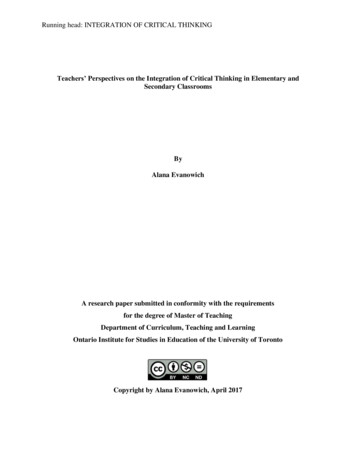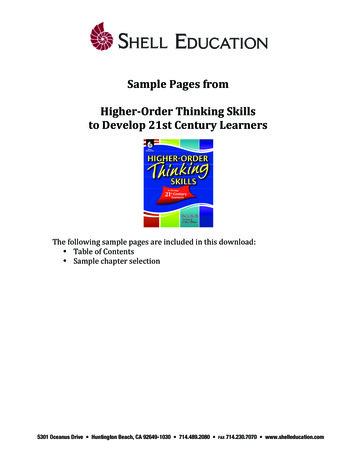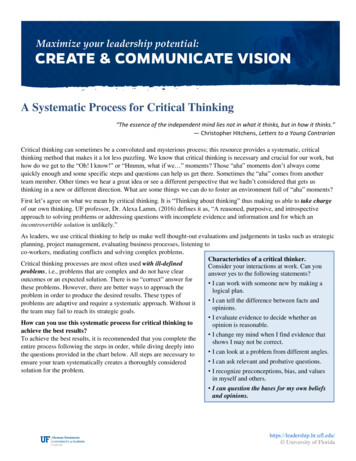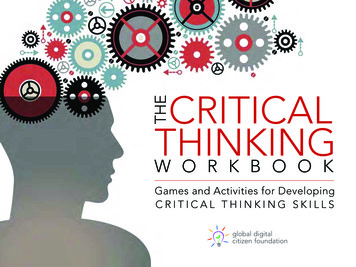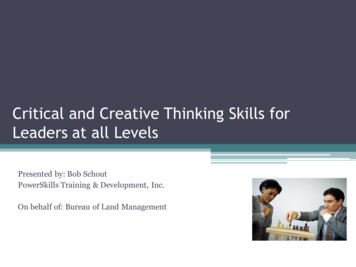
Transcription
Critical and Creative Thinking Skills forLeaders at all LevelsPresented by: Bob SchoutPowerSkills Training & Development, Inc.On behalf of: Bureau of Land Management
Perception: “F” CardsFEATURE FILMS ARE THE RESULT OF YEARS OF SCIENTIFIC STUDY COMBINED WITHTHE EXPERIENCE OF YEARS
Section 1
Critical & Creative Thinking
Thinking StylesAbstractCharacteristicsIndicators inLanguageYou, most oftenare Who, on yourteam, is Your boss maybe 2001-2013 PowerSkills Training & Development, Inc. & Robert J. Schout All rights reserved.Email: bob@yourpowerskills.com Twitter@yourpowerskills Ph. 505-986-9208 www.yourpowerskills.comLinear
Creative Thinking(www.1000ventures.com; Vadim Kotelnikov)
Creative Thinking Skills & Abilities1.2.3.4.5.6.7.8.Suspend judgment (no right/wrong, good/bad)Subjective (personal viewpoints)Divergence (“another way of looking at it is”)Abstract (flexible, conceptual in nature, basedon principles in mind)Generative (“here’s another idea”)Associative (“it’s like this ”)Visual (pictoral, photographic, graphic)Cooperative (“yes, and ”)
Critical Thinking “Critical thinking is thinking that assesses itself" (Centerfor Critical Thinking, 1996b) Critical thinking is reflective reasoning about beliefsand actions. It is a way of deciding whether a claim isalways true, sometimes true, partly true, or false. Critical thinking asks us to consider whether a piece ofknowledge could be rationally justified with clarity andlogical consistency. One sense of theterm critical means crucial; a second sense derivesfrom Greek meaning discerning judgment
Critical Thinking Skills Observation Interpretation (i.e., a particularversionor adaptation of a work, method, or style) Analysis/Discrimination of Data Inference (i.e., a : the act of passingfrom one proposition, statement, orjudgment considered as true to anotherwhose truth is believed to follow from thatof the former; b : the act of passing fromstatistical sample data to generalizations(as of the value of population parameters)usually with calculated degrees ofcertainty) Evaluation Explanation Meta-cognition/Self-regulation(i.e., awareness or analysis of one's ownlearning or thinking processes)(www.rasmussen.edu)
Critical thinking calls for the ability to:1. Recognize problems or situations andcircumstances requiring concentratedthought (e.g., persistent resistance ofpeople on a team to interact with,relate to, and support one another)2. Understand the importance ofprioritization and order of precedencein problem solving (e.g., what is theunderlying priority/priorities in thesituation .harmony, productivity,avert dissention/conflict, service, etc.)3. Gather and marshal pertinent(relevant) information4. Recognize unstated assumptions andvalues5. Comprehend and use language withaccuracy, clarity, and discernment;expunging generalist terms (e.g., donot say:“we want people to getalong”)6. Interpret data, to appraise evidence andevaluate arguments (e.g., what is thereal meaning and impact of words,behaviors, tone, body language, habits,etc.)7. Recognize the existence (or nonexistence) of logical relationshipsbetween propositions and drawwarranted conclusions andgeneralizations8. Put to test the conclusions andgeneralizations at which one arrives9. Reconstruct one's patterns of beliefsand behaviors based on widerexperience10. Render accurate judgments aboutspecific things and qualities in everydaylife
Practices for Practicing Critical Thinking(Karen I. Adsit, Ed: Grayson H. Walker Teaching Resource Center) Journal or discuss most important lessonslearned or issues at hand; list possible questionsor concerns that others may have; etc. Group learning or conference stylelearning assignments – peer group discussion,coaching, cross-training in dialogue format, etc. Case studies Reciprocal peer questions Purposeful ambiguity
Section 2
Systems Thinking Systems thinking begins withidentifying the keystakeholders and processes inthe system – those people andprocesses that can help orhinder the achievement of aparticular goal or set of goals. 2001-2013 PowerSkills Training & Development, Inc. & Robert J. Schout All rights reserved.Email: bob@yourpowerskills.com Twitter@yourpowerskills Ph. 505-986-9208 www.yourpowerskills.com
Strategic Thinking Strategic thinking begins withstarting points, or the levers,for initiating a positive ripple orcascade effect with a group ora system. Strategic thinkingfocuses on the how, when,why and who. 2001-2013 PowerSkills Training & Development, Inc. & Robert J. Schout All rights reserved.Email: bob@yourpowerskills.com Twitter@yourpowerskills Ph. 505-986-9208 www.yourpowerskills.com
Opportunity Thinking Critical & Creative Problem ion PlanPeople1.1a.1b.1c.What steps are necessary to make eachreconstructed answer happen?Which items can be accomplished when RN: right now ST: short-term orLT: long-term Who should beresponsible Team leader?Team 5a.5b.5c.
YOU CANNOT SOLVE A PROBLEMFROM THE SAMECONSCIOUSNESS AS IT WASCREATED.
Opportunity Thinking Is optimistic and includes hope and positive thinking Includes all of the reasons why you think something will work Is constructive and generative Looks forward to finding benefits and advantages, and assesses thepast in the same way Looks at possibilities and options Is speculative and opportunity-seeking, and helps to generateproposals and suggestions Requires deliberate thought
Observation: Directed Attention QuadrantsRoomQuadrant 1Quadrant 2Quadrant 3Quadrant 4Interpretation 2001-2013 PowerSkills Training & Development, Inc. & Robert J. Schout All rights reserved.Email: bob@yourpowerskills.com Twitter@yourpowerskills Ph. 505-986-9208 www.yourpowerskills.com
Creative and critical thinking begins with perception:6 common failures in perception1.We fail to look for something2.We see only part of the situation3.We leave things out4.We fail to take consequences or other people’s thinking into account5.We fail to generate alternative6.We don’t allot enough time to see what can be, and needs to be, seen 2001-2013 PowerSkills Training & Development, Inc. & Robert J. Schout All rights reserved.Email: bob@yourpowerskills.com Twitter@yourpowerskills Ph. 505-986-9208 www.yourpowerskills.com
Section 3
D.A.T.T.(Source: Edward De Bono)Tool 1 -- Consequences and SequelsLook ahead to see the consequences ofan action, plan, decision, or rule.Tool 6 -- Alternatives, Possibilities,ChoicesDeliberately try to find other ways.Tool 2 -- Plus, Minus, InterestingEnsure that all sides of a matter have beenconsidered before a decision orcommitment is made.Tool 7 -- Other People's ViewsPut yourself in others' shoes.Tool 3 -- Recognize, Analyze, DivideBreak a larger concept into smaller, moremanageable parts.Tool 4 -- Consider All FactorsExplore all factors related to an action,decision, plan, judgment, or conclusion.Tool 5 -- Aims, Goals, ObjectivesFocus directly and deliberately on theintentions behind actions.Tool 8 -- Key Values InvolvedEnsure that your thinking serves yourvalues.Tool 9 -- First Important PrioritiesSelect the most important ideas,factors, objectives, consequences,etc.Tool 10 -- Design/Decision,Outcome, Channels, ActionDirect attention to the outcome of thethinking and action that follows.
Three Keys to Success (DATT)Directed Attention Thinking Tools (DATT)1. Focus: Know which tool you are using andwhere you are applying that tool2. Objectivity: Use the tools objectively, notjust to support or defend one viewpoint3. Comprehensiveness: Make an effort to becomprehensive and to scan as widely aspossible
OT Problem Solving Process1.2.3.4.5.Define the problema. Redefine the problem – state it in at leastfive different ways.Generate data about the problemGenerate ideas or alternate courses of action foreach problem statement: what are theopportunities/possibilities?Choose among the alternative solutionsCreate a plan of action for one or several of thealternative solutions, and implement the plan.
OT Alternative Problem StatementsDefining a problem in more than one way invites the problem solver togenerate multiple problem solutions from a variety of perspectives asdirected by the definition of the problem.This process focuses on identifying more than one definition of aproblem. Using an alternative definition, of people’s feelings about theCompany Parking Lot could be defined in the following ways:The parking lot is too small.Too many people want to drive to work.Too many people want to park in the lot.Too many people complain about the parking lot.Depending on the perspective the definition, and therefore the solutions,will differ. What are some of the differing solutions to the problemstatements listed above? Coming up with multiple statements andmultiple solutions will provide you with systemic resolutions.
P.M.I.P PLUSM MINUSI INTERESTING“It would be interesting if ” (options)“It would be interesting to see whether ” (testing ideas/theories)“What is interesting about this is ” (observations – obj. and subj.)
P.M.I.There are three situations in which the P.M.I.is very useful.1. Assessment2. Choice3. Design
C & S: Consequence and SequelWhen to use C & S Evaluation Prediction Design
CAF: Consider All Factors Purpose FactorsFeasibility FactorsFit FactorsAcceptance FactorsImpact FactorsInvolvement FactorsResource FactorsTimeline Factors
A.G.O.: Aims, Goals, ObjectivesWhen to use A.G.O.1. Drift and purpose2. Assessing and prioritizing multipleobjectives3. Developing alternative definitionsA.G.O. allows you to develop right now,short-term, and long-term objectives
O.P.V.: Other People’s ViewsHow to use OPV:1. List all those who are involved orwho can impact or will be impactedby the outcome2. Solicit and/or describe their points ofview and perspectives
F.I.P.: First Important PrioritiesUse FIP to narrow things down. Remember,not everything is equally important1. What are the things that have to be donefirst?2. What are the things that are mostimportant?
360 Approach to Change and Management ofChaotic Organizations32(Source: Peter Vail)Chaotic Stimuli/Desired Change Organization Immediate Short-term Long-termVisionStrategyMission &Values Culture Structure Skills LeadershipOrganization, Dept. &PeopleAssessinternal/externalstakeholder values Work Worker Work PlaceAdministrativeProcesses Decision Making Communication Participation Resources
The P Wheel 2001-2013 PowerSkills Training & Development, Inc. & Robert J. Schout All rights reserved.Email: bob@yourpowerskills.com Twitter@yourpowerskills Ph. 505-986-9208 www.yourpowerskills.com
SWOT Analysis SWOT analysis is identifying strengths,weaknesses, opportunities, and threatsGAP Analysis A gap is the difference between the currentstate and the future state. 2001-2013 PowerSkills Training & Development, Inc. & Robert J. Schout All rights reserved.Email: bob@yourpowerskills.com Twitter@yourpowerskills Ph. 505-986-9208 www.yourpowerskills.com
S.W.O.T. ANALYSISSTRENGTHSWEAKNESSESOPPORTUNITIESTHREATS 2001-2012 PowerSkills Training & Development, Inc. & Robert J. Schout All rights reserved.Email: bob@yourpowerskills.com Twitter@yourpowerskills Ph. 505-986-9208 www.yourpowerskills.com
S.W.O.T. ACTION SHEETStrengthsWhyMaintenance ActionsWeaknessesWhyReversal ActionsOpportunitiesHow Will They Advance UsCultivation ActionsThreatsHow Will They Hinder UsRemoval Actions 2001-2013 PowerSkills Training & Development, Inc. & Robert J. Schout All rights reserved.Email: bob@yourpowerskills.com Twitter@yourpowerskills Ph. 505-986-9208 www.yourpowerskills.com
About the speaker Bob Schout is a dynamic speaker, facilitator, trainer, writer and coach who delivers his powerful messageof organizational change and personal growth to audiences around the world. Bob is a forerunner inhis field, acting as a catalyst for building skills, spirit and community in the workplace. He providescustomized management training programs and riveting keynote presentations to corporations,government agencies and non-profit organizations. Bob draws on the strengths of his background,passion and skills to help individuals and organizations enhance relationships, increase productivityand create a culture and climate for success.His educational foundation in Management & Policy, Social Work and Pastoral Studies give him a trulyunique perspective on the issues facing organizations today. Now, more than ever, individuals arestriving for an ideal work/life balance. Bob directly addresses the growing need for spirit andcommunity at work through interactive programs and inspires audiences to create solutions at thepersonal, interpersonal and organizational levels. Audiences rave about his engaging and impactfulpresentations.Bob Schout is a Chicago native with a BA in Social Work and Psychology from Loyola University ofChicago, a MA degree in Social Work and Organization Management & Policy from the University ofIllinois and a certificate in Pastoral Studies from Loyola Institute of Pastoral Studies in Chicago. Bobcurrently lives in Santa Fe, NM.As an attendee of his workshops, Bob asks the you use this material for internal purposes only, lettingBob know when and for what purpose you’re using it, and giving the appropriate credit whereappropriate. For further information, questions, or to schedule another presentation with Bob, pleasecontact:505-986-9208 (office)619-517-6299 (mobile)
Training & Consulting Services offered byPowerSkills Training & Development, Inc.oooooooooooo16 Life Skills for Personal Mgt and Work-Life BalanceAccountability Principles and PracticesAdvocacy and Social Justice SkillsAnti-Bullying Campaigns for the Workplace & SchoolsAnger Management at WorkAttitude Adjustments at WorkBoard DevelopmentChange ManagementCoaching and Counseling Skills for Professionals in the Work EnvironmentCoaching Skills TrainingBasic Skills for Counseling Assessment which Support Coaching, Mentoring and SupervisoryInteractionsCommunication Skills for ProfessionalsEngaging in Compassionate Communication Skills for De-Escalating Intense InteractionsUnderstanding Communication General Principles, Methods, Tools and Practices; Understandhow to Give & Receive FeedbackPublic Speaking Tips, Tools & TechniquesConfidentiality and Interviewing Skills for Helping and Client Service ProfessionalsConflict Management Skills TrainingAssessing and Resolving Intra-personal, Inter-personal, Project-Related and OrganizationallyDriven ConflictsDiagnosing Workplace Norms that Aggravate Relationships at WorkUnderstanding & Managing Conflict StylesCreative and Critical Thinking SkillsCultural Competencies and Diversity AppreciationFearlessly and Diplomatically Facing Attitudes about Race, Ethnicity, Age, Orientations, and Faithin the WorkplaceAddressing Harassment and Discrimination in the WorkplaceTapping the Strengths of Four Generations in the WorkplaceUnderstanding and Managing Styles at Work (e.g., work styles, learning styles, listening styles,personality styles, etc.)Customer Service Excellence Skills for Internal & External CustomersDealing with Addictions: Understanding Addictive-Compulsive Behaviors and Applying 12 StepModels in the Work EnvironmentDecision-Making Skills, Practices and ProcessesDe-escalating Aggression & Workplace ViolenceDelegation Skills and TechniquesEmotional Intelligence SkillsEmpowerment Strategies for the WorkplaceEthics, Values and Virtues at WorkExpectations and Standards: Setting them and Making them StickForgiveness at Work: Practices that Help Your People Let Go, Own Up and Move OnHuman Resource On-Boarding PracticesooooooooooooooooooLeadership DevelopmentInspired Leadership: Becoming a Leadership StarLeading Regardless of Level (a.k.a. Leadership for Non-Supervisors)Moving from Peer-to-Leader at WorkLeading in all Situations (Problem-Solving, Empowerment, Performance Adjustment, Praise andMotivation, Recognition & Rewarding People)Servant Leadership: Becoming a Servant Leader and Creating a Culture for Leadership so that allmay Step into LeadershipPersonal Leadership in a Professional Environment: Engaging in Self-Awareness, Self-Assessment,virtue and value-based development, managing thoughts and emotions and moreStrategic Leadership Skills for change planning, individual development planning, project and programplanning, vision-planning, succession planningMeeting ManagementMental Health IssuesDealing with Bigotry & Bias within clientsWorking with MSM to reduce StigmaHealing Religious WoundsIntegrating Spirituality into TreatmentInterviewing TechniquesConfidentiality & other Ethic StandardsUnderstanding AddictionsBecoming an Effective Advocate & AllyConfronting & Counteracting BullyingWorking Effectively with GLBTQ ClientsGang Intervention StrategiesMentor Program DevelopmentMotivation and Morale Building at WorkNavigating Political Landscapes at WorkNon-Profit Management 101Non-Profit Resource DevelopmentOrganization Development: Culture and Climate Diagnosis and EnhancementPerformance Management SkillsPersonality ProfilingPower-Development, Influence and Negotiation Skills for ProfessionalsProblem-Solving Skills TrainingProject and Program Management TrainingRecognition and Rewards at WorkRelationship Building Skills for ProfessionalsStrategic Thinking and PlanningStress Management and Work/Life BalanceStyles at WorkSuccession Planning Skills and StrategiesSupervisory Skills TrainingTeam Building and Group Work SkillsTele-Work Management Skill-BuildingTime and Task Management TrainingTraining-the-Trainer and Facilitation Skill-BuildingUnderstanding Mental Health Issues at WorkVolunteer & Internship Management Skills
For More Information Contact:Bob SchoutPowerSkills Training & Development, Inc.Mobile: 619-517-6299Office:505-986-9208Email: ices offered:E-mail: bob@yourpowerskills.comWeb: www.yourpowerskills.comRetreat & Meeting FacilitationPersonal & Professional Life CoachingKeynote PresentationsStrategic Planning & SupportExecutive CoachingEmployee & Management TrainingOrganizational DevelopmentTele-Class Delivery
Critical and Creative Thinking Skills for Leaders at all Levels Presented by: Bob Schout PowerSkills Training & Development, Inc. . Strategic thinking begins with starting points, or the levers, fo




